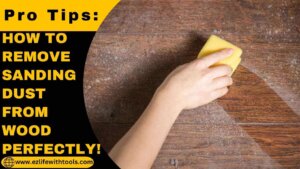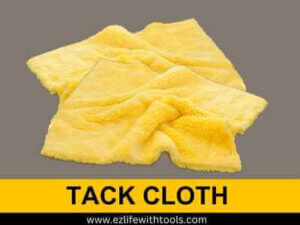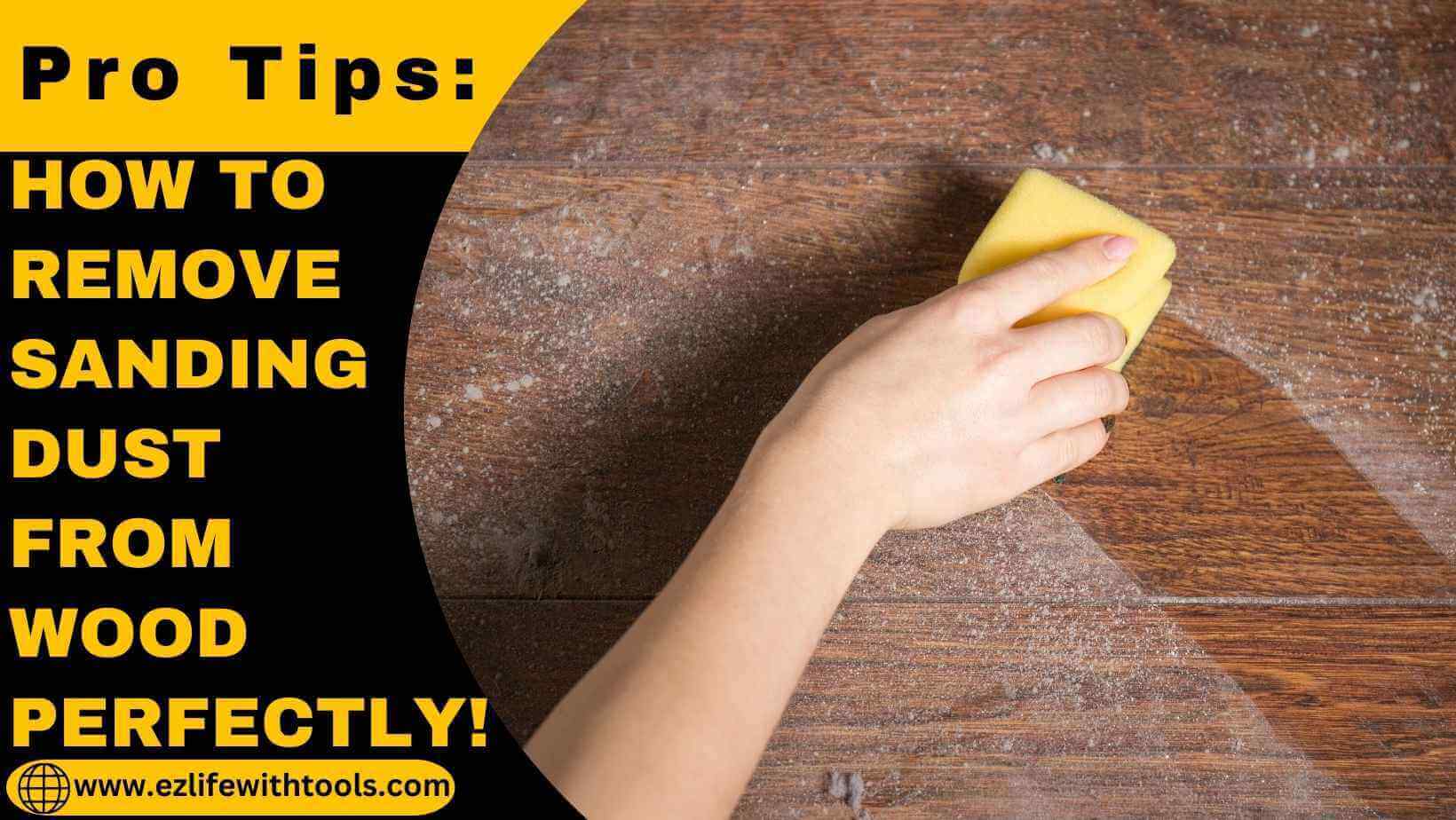Removing sanding dust from wood is essential for achieving a beautiful, smooth finish on any woodworking project. Whether you’re working on a large hardwood floor or a small wooden piece, the finishing stage demands careful attention.
project. Whether you’re working on a large hardwood floor or a small wooden piece, the finishing stage demands careful attention.
Even the finest dust particles, though virtually invisible, can leave traces that spoil the topcoat or give a muddy color to paint and stain.
Without precise cleaning, the surface may feel rough to the touch and look flawed. Many woodworking teams and enthusiasts agree that a multi-step cleaning process is best for high-quality results.
Quick Solution: Start by gently wiping down the wooden surface with a microfiber cloth to capture the sawdust. Follow this with a vacuum cleaner attachment to remove any excessive dust, ensuring you leave no traces behind. For an at-home project, a soft brush can help reach into grooves.
After vacuuming, use a tack cloth to pick up the finest particles—this is key to preparing the wood for staining or painting. Many cleaning routines suggest a final swipe with mineral spirits to eliminate any lingering dust on the surface. By being careful and precise, you’ll avoid a rushed job and instead be rewarded with a smooth, professional look on your next refinishing or varnish job, even on teak or other wood types.
If you want to learn the step by step process about how to remove sanding dust from wood, keep reading…
The Importance of Removing Sanding Dust Before Finishing
In my experience, sanding dust is more than just an inconvenience—it’s a hidden factor that can make or break the final appearance of a wood finish. When sanding, tiny particles of dust settle on the surface and cling to even the smallest crevices and pores.
If these particles aren’t properly removed, they can become trapped under the finish, leaving a rough texture that impacts the quality and smoothness of the final look. This often-overlooked step of removing sanding dust is crucial to achieve a smooth, professional result.
Skipping it can cause the finish to look dull or uneven, affecting the appearance and overall quality of the project. By making sure every bit of dust is gone, you can bring out the natural beauty of the wood and ensure a stunning, long-lasting finish that stands out.
Potential Issues Caused by Sanding Dust
Sanding dust left on wood can create a significant impact on the wood finishing process. Even a small amount of residual dust can interfere with the adhesion of paints, sealants, or finishes, creating a barrier that prevents products from bonding properly.
This leads to inconsistent results, with clumps or patchy areas, which can make the surface look streaky or blotchy. Dust particles can also get trapped under layers of varnish or polyurethane, resulting in unwanted imperfections or bumps that detract from the silky-smooth finish you’re aiming for.
Beyond aesthetics, trapped dust affects the durability and quality of the woodwork. For instance, a dusty surface can cause finishes to wear off faster or develop a rough texture that feels incomplete and messy to the touch.
This dust can mar the character and beauty of the wood’s grain pattern by causing stain to soak unevenly, resulting in a blotchy appearance that diminishes the polished look. In professional projects, ignoring proper dust removal can lead to signs of unfinished work, requiring re-sanding and refinishing that’s time-consuming and labor-intensive to correct.
Benefits of Removing Sanding Dust
Removing sanding dust is an essential extra step that helps create a smooth, clean base for a polished, professional finish on wood. By eliminating every trace of dust, you allow stains, clear varnish, and sealants to adhere evenly and penetrate deeply into the wood, enhancing both the durability and aesthetics of your final product.
This minor cleanup task lays the groundwork for a dust-free, flawless appearance that showcases the natural grain and brings out a rich, warm color in the wood. Experienced woodworkers know that a dust-free surface is vital for achieving a uniform color and even protection across the entire piece.
Without this step, the finish may not adhere as intended, which can lead to an uneven look that detracts from the beauty and quality of your project. Taking the time to thoroughly clean off dust ensures that your work will stand the test of time and be an investment in a truly impressive result.
Essential Tools and Materials for Removing Sanding Dust
Any lingering sanding dust can ruin the smoothness of a finish, leaving rough patches and uneven tones. To ensure you get the best result possible, having the right tools and supplies is key.
Here’s a look at the tools and materials you’ll need to effectively remove sanding dust from wood before applying a finish.
- Clean Microfiber cloths
- Tack cloths
- Shop vacuums (with HEPA filters)
- Air compressors or dust blowers
- Small and Large Paint Brushes
- Mineral spirits (optional)
- Denatured alcohol
- Diluted trisodium phosphate
Clean Microfiber Cloths
Microfiber cloths are perfect for dust removal as their ultra-fine synthetic fibers are specially designed to trap dust particles without scratching. The soft texture of microfiber makes it gentle on wood, ideal for a final pass to pick up fine dust after sanding. With a clean, dry microfiber cloth, you can gently wipe the entire surface, removing any leftover particles that could interfere with the finish.
Tack Cloths
Tack cloths use a sticky substance to pick up and hold even the smallest dust particles. After an initial dusting with a microfiber cloth, a tack cloth helps catch lingering debris. Gently wipe the surface with light pressure to avoid leaving any residue that could transfer to the wood, ensuring a cleaner base for finishing.
Shop Vacuums with HEPA Filters
A shop vacuum with HEPA filters is essential for capturing the finest particles and preventing them from becoming airborne and resettling on the wood. By using a vacuum with an attachment that glides smoothly over surfaces, you can cover large areas without risk of scratches, quickly clearing dust after sanding.
Air Compressors or Dust Blowers
An air compressor or dust blower is excellent for blowing away dust particles in intricate pieces or carved areas. These tools reach hard-to-reach places where cloths and vacuums may miss, ensuring that particles are thoroughly cleared without being redistributed onto other surfaces.
Small and Large Paint Brushes
For detailed dusting of fine details and broad surfaces, paint brushes in various sizes work well. A large brush is useful for quickly dusting flat surfaces, while small brushes can reach into crevices and edges of detailed carvings to remove any remaining particles before finishing.
Mineral Spirits
Mineral spirits can be used for a final cleaning to lift residual oils and fine dust. Apply a small amount to a clean cloth and gently wipe the wood, allowing it to evaporate for a dust-free surface. Mineral spirits are particularly useful on oily woods that might be prone to a sticky residue.
Denatured Alcohol
For a final wipe-down, denatured alcohol effectively removes oils and dust while evaporating quickly to leave a smooth, finish-ready surface. It helps create a pristine base, essential for achieving a flawless result in the finishing process.
Diluted Trisodium Phosphate (TSP)
For stubborn residue or grime, trisodium phosphate (TSP) is an effective cleaning solution. Diluted with water, it can be applied with a cloth to remove accumulated oils and stains on older surfaces. After using TSP, rinse the wood with water and let it dry completely before refinishing.
Step-by-Step Dust Removal for a Flawless Finish
Achieving a professional-grade finish on wood requires careful attention to detail with thorough dust removal. By eliminating dust completely, you avoid a blotchy or uneven look, allowing each layer of finish to bond smoothly and enhance the wood’s natural beauty.
Method 1: Using a Vacuum to Remove Sanding Dust from Wood
Prepare the Vacuum Properly
To effectively tackle sanding dust on wood, start by preparing a shop vacuum with a HEPA filter that’s designed to trap fine dust particles. This filter is crucial for preventing dust from blowing back into the room, which would otherwise cause it to resettle on your wood surfaces. Using a vacuum with specialized filters is especially useful for large projects with heavily sanded surfaces, as it helps pull in all the dust without creating new messes.
Use the Correct Attachment
For the best results, use a soft-bristle attachment on the vacuum to safely clean the wood surface. The soft bristles help loosen and capture particles without scratching or denting the wood. This attachment is ideal for a smooth surface finish, especially on delicate wood where standard brushes may be too harsh.
Vacuum Slowly and Methodically
When vacuuming, work in small sections and move the vacuum head with slow, steady movements to ensure that each particle is captured without stirring up dust into the air. This careful approach is important for edges, corners, and other areas where dust may settle deeply. If necessary, repeat the process to catch any lingering particles that may have been missed.
Double-Check for Remaining Dust
After the initial vacuuming, inspect the surface closely, preferably under a light source to spot any missed dust particles. Sometimes tiny particles can still linger, so take a closer look and use the vacuum to pick up any that are still visible. This ensures a clean wood surface, ready for the next steps in your project.
Note:
Using a vacuum is one of the most effective methods for removing sanding dust, but keep in mind that even the best vacuums might miss tiny particles. Following up with a tack cloth or another tool can be valuable to achieve a pristine, dust-free surface.
Method 2: Tack Cloth Technique to Remove Sanding Dust from Wood
Gently Unfold and Prepare the Tack Cloth
Begin by carefully unfolding the tack cloth to expose a larger surface area for cleaning. Avoid scrunching it too tightly, as this can reduce its effectiveness in picking up fine dust particles. Tack cloths are treated with a specialized sticky substance designed to attract and hold any remaining dust, so unfolding it fully helps cover more of the wood surface.
Use Light, Even Pressure
To use the tack cloth effectively, gently swipe it across the wood surface with light, even pressure. The tacky material is designed to naturally grip particles without too much force, so pressing lightly is all you need to avoid leaving residue on the finish. A gentle touch ensures that you cover all areas without creating spots where dust might remain.
Avoid Pressing Down on Corners or Carvings
In detailed or intricate sections, avoid pressing the tack cloth too hard into crevices or edges. Instead, fold the cloth to fit narrow spaces and dab or lift it gently to remove dust without risking any finish issues. For especially tight spots, a light swipe with the cloth can be effective without dragging on the wood.
Check for Tack Cloth Residue
Finally, visually inspect the surface for any remaining dust or tacky spots left by the tack cloth. In bright lighting, you’ll be able to notice any areas that may still have dust or residue. Use a clean, dry microfiber cloth to remove any excess stickiness before applying your finish, ensuring the wood is fully prepared.
Method 3: Wiping with a Damp Cloth to Remove Sanding Dust from Wood
Choose a Microfiber Cloth and Dampen It Lightly
Select a clean, high-quality microfiber cloth and dampen it lightly for dust removal. The microfiber should be only slightly damp to avoid dripping wetness, which could cause swelling or damage to certain types of wood grain. A small amount of moisture is ideal to help the cloth hold onto dust particles without affecting the wood.
Wipe the Wood Surface Gently
With the damp cloth, use smooth strokes to gently wipe the wood surface. Moving slowly helps the cloth’s ultra-fine synthetic fibers to securely hold and trap any lingering dust particles from previous cleaning. This method is particularly effective in picking up even the tiniest specks of dust that may be left on the surface.
The Benefits of Microfiber in Dust Removal
Microfiber cloths are especially effective due to their positively charged fibers that work like a magnet for dust, unlike standard cotton cloths, which can simply push dust around. These synthetic fibers are designed to capture deeper particles for a much cleaner, dust-free surface that’s ideal for finishing.
Check the Surface After Wiping
Once you finish, inspect the wood surface in good lighting to ensure no particles remain. Look for any missed spots or dust that could interfere with a perfect finish. If needed, gently go over any remaining areas with the microfiber cloth to make sure the surface is completely dust-free and ready for applying the finish.
Method 4: Air Compressor or Dust Blower to Remove Sanding Dust from Wood
When to Use an Air Compressor or Dust Blower
An air compressor or dust blower is ideal for intricate or carved wood pieces where dust tends to settle into small crevices. This tool is indispensable for quickly clearing dust from hard-to-reach areas in detailed projects with grooved or decorative designs.
How to Use It Effectively
For carved or grooved woodwork, use the air compressor at low to medium pressure to avoid scattering dust or damaging delicate woodwork. Hold the nozzle a few inches from the wood and direct the airflow into crevices and intricate sections systematically, moving from top to bottom to prevent dust from resettling onto cleaned areas.
Safety Tips to Avoid Scattering Dust
To minimize spreading dust around, work in a ventilated workspace and, if possible, use a portable dust collector to capture airborne particles. Wear a mask and goggles to protect your lungs and eyes, and angle the airflow consistently in one direction to avoid dust migrating onto other surfaces you want to keep clean.
Check for Residual Dust
After using the air compressor, double-check the wood for any residual particles. Use a microfiber cloth for a final pass to catch any dust that may have been missed, ensuring a dust-free surface ready for a flawless finish.
Method 5: Mineral Spirits for Deep Cleaning to Remove Sanding Dust from Wood
When to Use Mineral Spirits
Mineral spirits are ideal when you need an extra level of dust removal and surface preparation. This optional but highly effective method provides a thorough, deep clean, especially for dense, oily woods that may have natural oils or fingerprints that interfere with stains or sealants. By removing every trace of oil and dust, mineral spirits create an ideal base for finishing.
How to Safely Use Mineral Spirits
Apply a small amount of mineral spirits on a lint-free, clean cloth and wipe gently across the wood, without saturating it, to avoid any seepage into the wood. Always work in a well-ventilated area to prevent inhaling hazardous fumes, and wear gloves and protective eyewear to avoid skin or eye irritation from the mineral spirits.
The Benefits of Using Mineral Spirits
Using mineral spirits removes residue without altering the wood’s grain or texture, leaving a dust-free, smooth surface that enhances the adhesion of finishes. This method helps eliminate oils and contaminants, ensuring a long-lasting, clean finish that is particularly effective on oily woods, providing a well-prepared, smooth base for your next steps.
Let the Wood Dry Completely
After wiping, allow the wood to dry completely for a few minutes to ensure all moisture has evaporated. This wait time prevents any interference with the finish and ensures the surface is truly ready. Make sure the wood is fully dry to achieve the best adhesion and a flawless, dust-free finish.
Tips for Preventing Sanding Dust Accumulation During Woodworking
Achieving a clean, professional finish in woodworking requires minimizing excessive dust right from the start. These strategies not only make woodworking smoother but also enhance the finish quality by maintaining a clean surface.
Using Dust Collectors or Vacuums Attached to Sanders
For effective dust control, attaching a dust collector or vacuum system to your sander is key to keeping your workspace cleaner and your project dust-free. Many modern sanders come with ports that let you connect directly to a dust collection system, which captures dust particles at the source.
This approach reduces floating dust in the air, creating a cleaner environment and preventing extensive cleanup steps later. Using these tools means less airborne dust, making sanding safer and more enjoyable.
Setting Up a Dust-Free Workspace
Creating a dedicated, dust-free workspace can greatly improve your woodwork quality. Set up a closed-off area in your workshop or garage with a filtration system to trap floating particles before they spread.
A screened-off area helps keep the environment clean by limiting outside dust from entering and reducing dust buildup on your project. By controlling the dust in a sealed-off area, you can ensure the wood surface remains clean and smooth, with less hassle over dust removal.
Wearing Dust-Protective Gear for Personal Safety
In a dusty workspace, protective gear is essential for health and safety. Use a mask or respirator to avoid breathing in fine particles that can irritate the lungs, and wear goggles to protect your eyes from flying dust. Work gloves help keep your hands safe and prevent dust from transferring to your skin.
This protective gear not only protects you from respiratory issues but also prevents dust from irritating your eyes or clothing, making it safer and more comfortable to work on your project.
Common Mistakes to Avoid When Removing Sanding Dust
Sometime, experienced woodworkers sometimes make simple mistakes that can affect the final result. Here, we’ll look at common dust removal errors.
- Skipping the dust removal step entirely.
- Using overly damp cloths (which can damage wood).
- Forgetting to check for residual dust before applying the finish.
Skipping the Dust Removal Step Entirely
One of the most significant mistakes woodworkers make is skipping the dust removal step after sanding. Ignoring this step means fine dust particles stay on the wood, which can lead to rough, uneven, and blotchy finishes.
Many assume a quick wipe or vacuum is unnecessary, but thorough preparation is key to achieving a clean, smooth surface. Without proper dust removal, a layer of particles can act as a barrier, reducing the adhesion of the finish and causing it to peel or wear out quickly, leaving a project that feels incomplete.
Using Overly Damp Cloths
A common error is using an overly damp cloth to remove dust. Excess moisture can trap particles and even raise the grain, leading to a rough, uneven surface. This can result in dried swelling or warping of the wood, which may affect the final staining and finish.
Using a microfiber cloth is excellent for this purpose as it effectively picks up dust without leaving excess moisture behind. While a slightly wet cloth can be helpful, it’s essential to avoid excessive dampness to maintain a clean, smooth surface.
Forgetting to Check for Residual Dust Before Applying the Finish
Thorough dusting is essential to remove any residual dust that might still cling in crevices and edges. These remaining particles can create imperfections that affect both the appearance and durability of the finish.
Double-checking under good lighting helps to catch any particles that might be left, ensuring a perfectly smooth surface. By taking the extra time to prevent trapped dust, you enhance the overall look of the finish and impact its longevity on the wood.
Final Preparation Steps Before Applying Finish
To achieve a smooth, professional finish on wood, meticulous preparation is essential. After initial sanding, thorough dust removal is one of the key steps to ensure a completely clean surface before applying any finishing products. Following these tips will help you achieve a beautifully finished piece that showcases your attention to detail and commitment to quality.
Inspecting the Surface for Any Remaining Dust or Imperfections
After sanding, it’s important to inspect the wood surface for any lingering dust or imperfections. Even the smallest particles left behind can create a rough, noticeable finish, detracting from the appearance and quality of the project.
Start by examining the surface in bright lighting—natural or direct from a strong lamp—to reveal any flaws that might have gone unnoticed. This visual inspection helps to catch particles or uneven spots that could affect the finish. Taking the time to check for small bumps or rough areas will make a big difference in the final look of your work.
Using both a visual inspection and a hand feel is essential for a thorough check. Run your fingertips lightly over the surface to detect tiny particles or rough patches that may be hard to see but are still there.
A tack cloth is useful for removing any fine, remaining dust without leaving residue, ensuring the wood is even and smooth. Paying attention to these small details during dust removal ensures a perfect, clean surface for finishing and prevents uneven areas from impacting your final result.
Best Practices for Ensuring the Wood is Completely Clean and Ready for Finishing
To confirm the wood surface is free of dust and imperfections before finishing, it’s helpful to follow a few best practices that make a real difference in the quality of the final finish.
Use a Slightly Damp Microfiber Cloth
For initial dust removal, use a slightly damp microfiber cloth to trap fine particles without causing any damage to the wood. This method is excellent for capturing dust and remaining particles without raising the grain, as long as you avoid excessive moisture that could cause warping or other issues.
A microfiber cloth does a great job of picking up dust while keeping the wood’s surface smooth and intact, making it ideal for this step.
Employ an Air Compressor for Detailed Areas
For projects with intricate carvings or tight crevices, using an air compressor or dust blower can help to remove dust from hard-to-reach areas. Setting the compressor to low pressure helps direct clean airflow without scattering dust around the workspace.
This step is especially helpful for ensuring that all parts of the project are thoroughly cleaned, including the detailed sections, without disrupting the main surface.
Consider a Final Wipe with a Tack Cloth
Using a tack cloth for a final pass over the wood surface is one of the best methods for capturing any fine particles missed in previous steps.
The sticky texture of the tack cloth is perfect for a gentle pass, ensuring even the smallest specks are removed, leaving the wood fully prepared for the finish. This final pickup step guarantees a perfectly clean surface, ready for that flawless coat.
Bonus
Tips on Choosing the Right Finishing Products for an Even, Professional Look
Choosing the right finishing products is an important step that can significantly impact the final look and durability of your wood project. The type of finish you select should suit the wood characteristics and bring out the professional, even finish you’re aiming for.
Each project type may require a different approach, so considering the wood’s natural qualities and what finish best enhances them is key to achieving a polished look.
Select a Finish Based on Wood Characteristics
Different woods absorb finishes uniquely; for example, open-grained woods like oak or ash may need a filler for a smooth base, while denser woods like maple or cherry often need less prep.
Using an oil-based finish can bring out the wood’s natural grain with a rich, warm look that highlights its unique qualities, making it a good option for many wood types. Applying finishes that enhance the natural grain allows you to achieve a balanced and beautiful finish.
Consider Oil-Based Finishes for a Natural, Deep Look
Oil-based finishes like Tung oil or Danish oil are excellent for showcasing the natural beauty of wood by penetrating deeply and enhancing patterns and grain.
These finishes provide a rich look and are durable, making them ideal for wood projects where the grain and natural appearance are central to the design. Applying multiple coats can enhance the depth, making the surface look more refined and professional.
Use Polyurethane for Enhanced Durability
For projects needing extra protection, such as tabletops or floors, polyurethane is a top choice. Both water-based and oil-based versions offer durability against moisture, scratches, and heat.
While water-based polyurethane dries faster and forms a clear coat, oil-based options add a slight warmth to the wood’s color. Polyurethane is an excellent choice for areas that see heavy use, as it forms a durable shield over the wood surface.
Experiment with Stains for Custom Color
To alter the wood’s natural color, stains provide a wide range of shades to customize the look of your project. It’s helpful to test on a small scrap piece to ensure the desired shade before committing to the final piece.
When applying, use a brush or cloth, wiping off excess for a consistent and even look. This final step can transform the wood’s appearance and add a layer of depth that complements the finish.

